The Spatiotemporal Links between Urban and Rural Regions through the Sale and Consumption of Agri-Food Products
Abstract
1. Introduction
2. Data and Methods
2.1. Oporto and Lisbon Case Studies
2.2. Analytical Framework
2.2.1. Data Collection and Pre-Processing
- Cluster 1 (“Wine Focused”) includes stores (N = 13, 11.5%) that almost exclusively sell wines and other beverages. This is the least represented cluster in the sample. It is important to note that compared to the other two clusters, the stores in this cluster do not sell any product without a certification seal, and most wines have the Denomination of Controlled Origin (DOC) or Protected Geographical Indication (PGI) designations. Compared to the other clusters, this one tends to promote “Cooking Workshops/Courses” more often.
- Cluster 2 (“The Rural Provenance Focused”) includes stores (N = 41, 41.8%) that, although they sell a wide variety of food products of rural origin, sell mainly “Cheese and other dairy products” and “Meat, sausages, and other sub-products of animal origin”. This cluster is the second most representative cluster of stores. These stores, compared to the other clusters, tend to be a group of stores with a more represented family structure that opened before the year 2000. Furthermore, these stores tend to acquire their products in both ways: both directly from the producer and through the distributor.
- Cluster 3 (“The Generalist”) includes stores (N = 44, 44.8%) which, compared to other clusters, are characterized by the sale of vegetables (and related products) and other products as well as olive oil. This is the cluster with the highest representation in the sample; however, it is also the cluster with a greater variety of other sold products. In addition, the stores are more likely to sell hygiene and cleaning products (soaps, shower gel) and other foods that use raw materials from rural sources such as beeswax, honey, olive oil, goat and donkey milk. In this cluster, the store owners are part of collective companies and have a greater preference for buying directly from the producer, namely vegetables and olive oil.
2.2.2. Geospatial Analysis
3. Results and Discussion
3.1. Geodemography of the Cities of Oporto and Lisbon
3.2. Spatial and Temporal Evolution and Influence Area of Store Locations in the Cities of Oporto and Lisbon
- In all of them, the directional distribution increased in area, moving from an ellipsoid shape to a more harmonized circular shape and dispersed throughout the urban territory. This situation is, however, more evident in the city of Lisbon, which is partly due to its greater extension and the existence of several urban ‘centers’;
- Most of the stores in the two cities opened in the last decade and a half, although there are centenary stores in the cities of Oporto and Lisbon. The recent nature of these stores draws attention to their probable relationship with the increase in tourist flows that have been observed in the three cities in recent years;
- The greater concentration of stores in the historic centers or in their immediate vicinity also suggests their greater focus on marketing agri-food products of rural origin to visitors and tourists without prejudice to the fact that in some cases, the focus is also on local residents.
3.3. Supply Chains for Agri-Food Products in the Cities of Oporto and Lisbon
4. Conclusions
Author Contributions
Funding
Institutional Review Board Statement
Informed Consent Statement
Data Availability Statement
Acknowledgments
Conflicts of Interest
References
- Nishimura, A.Z.F.C.; Moreira, A.; Au-Yong-Oliveira, M.; Sousa, M.J. Effectiveness of the Portugal 2020 Programme: A Study from the Citizens’ Perspective. Sustainability 2021, 13, 5799. [Google Scholar] [CrossRef]
- O’Connell, V. Synthesised Policy Recommendations Relevant to Rural-Urban Interactionsand Interdependencies; European Union: Brussels, Belgium, 2021. [Google Scholar]
- Lavrador, A.; Rocha, J. The Role of Landscape in the Representation of Portuguese Wine Producing Regions. In Geospatial Intelligence; IGI Global: Hershey, PA, USA, 2019; pp. 1602–1623. [Google Scholar]
- Pacciani, A.; Belletti, G.; Marescotti, A.; Scaramuzzi, S. The Role of Typical Products in Fostering Rural Development and the Effects of Regulation (EEC). In Proceedings of the 73rd Seminar of the European Association of Agricultural Economists, Ancona, Italy, 28–30 June 2001. [Google Scholar]
- Fonte, M. Knowledge, Food and Place. A Way of Producing, a Way of Knowing. Sociol. Rural 2008, 48, 200–222. [Google Scholar] [CrossRef]
- Bianchi, C.; Mortimer, G. Drivers of Local Food Consumption: A Comparative Study. Br. Food J. 2015, 117, 2282–2299. [Google Scholar] [CrossRef]
- Aprile, M.C.; Caputo, V.; Nayga, R.M., Jr. Consumers’ Valuation of Food Quality Labels: The Case of the European Geographic Indication and Organic Farming Labels. Int. J. Consum. Stud. 2012, 36, 158–165. [Google Scholar] [CrossRef]
- Balogh, P.; Békési, D.; Gorton, M.; Popp, J.; Lengyel, P. Consumer Willingness to Pay for Traditional Food Products. Food Policy 2016, 61, 176–184. [Google Scholar] [CrossRef]
- Calvo-Porral, C.; Lévy-Mangin, J.-P. From “Foodies” to “Cherry-Pickers”: A Clustered-Based Segmentation of Specialty Food Retail Customers. J. Retail. Consum. Serv. 2018, 43, 278–284. [Google Scholar] [CrossRef]
- González-Azcárate, M.; Cruz Maceín, J.L.; Bardají, I. Why Buying Directly from Producers Is a Valuable Choice? Expanding the Scope of Short Food Supply Chains in Spain. Sustain. Prod. Consum. 2021, 26, 911–920. [Google Scholar] [CrossRef]
- Watts, D.; Little, J.; Ilbery, B. ‘I Am Pleased to Shop Somewhere That Is Fighting the Supermarkets a Little Bit’. A Cultural Political Economy of Alternative Food Networks. Geoforum 2018, 91, 21–29. [Google Scholar] [CrossRef]
- Figueiredo, E. Rural Provenance Food as Cultural Heritage: A Way of Promoting Territorial Development? In Handbook of Research on Cultural Heritage and Its Impact on Territory Innovation and Development; Oliveira, L., Amaro, A.C., Melro, A., Eds.; IGI Global: Hershey, PA, USA, 2021; pp. 114–137. ISBN 9781799867012. [Google Scholar]
- Wilson, G.A.; Whitehead, I. Local Rural Product as a ‘Relic’ Spatial Strategy in Globalised Rural Spaces: Evidence from County Clare (Ireland). J. Rural Stud. 2012, 28, 199–207. [Google Scholar] [CrossRef]
- Bianchi, C. Exploring Urban Consumers’ Attitudes and Intentions to Purchase Local Food in Chile. J. Food Prod. Mark. 2017, 23, 553–569. [Google Scholar] [CrossRef]
- Goodman, D. The Quality ‘Turn’ and Alternative Food Practices: Reflections and Agenda. J. Rural Stud. 2003, 19, 1–7. [Google Scholar] [CrossRef]
- Renting, H.; Marsden, T.K.; Banks, J. Understanding Alternative Food Networks: Exploring the Role of Short Food Supply Chains in Rural Development. Environ. Plan. A Econ. Space 2003, 35, 393–411. [Google Scholar] [CrossRef]
- Morris, C.; Buller, H. The Local Food Sector. Br. Food J. 2003, 105, 559–566. [Google Scholar] [CrossRef]
- Murdoch, J.; Marsden, T.; Banks, J. Quality, Nature, and Embeddedness: Some Theoretical Considerations in the Context of the Food Sector*. Econ. Geogr. 2000, 76, 107–125. [Google Scholar] [CrossRef]
- Figueiredo, E.; Raschi, A. Immersed in Green? Reconfiguring the Italian Countryside Through Rural Tourism Promotional Materials. In Field Guide to Case Study Research in Tourism, Hospitality and Leisure; Hyde, K.F., Ryan, C., Woodside, A.G., Eds.; Advances in Culture, Tourism and Hospitality Research; Emerald Group Publishing Limited: Bingley, UK, 2012; Volume 6, pp. 17–44. ISBN 978-1-78052-742-0/978-1-78052-743-7. [Google Scholar]
- Renko, S.; Renko, N.; Polonijo, T. Understanding the Role of Food in Rural Tourism Development in a Recovering Economy. J. Food Prod. Mark. 2010, 16, 309–324. [Google Scholar] [CrossRef]
- Soares da Silva, D.; Figueiredo, E.; Eusébio, C.; Carneiro, M.J. The Countryside Is Worth a Thousand Words–Portuguese Representations on Rural Areas. J. Rural Stud. 2016, 44, 77–88. [Google Scholar] [CrossRef]
- Marsden, T.; Sonnino, R. Rural Development and the Regional State: Denying Multifunctional Agriculture in the UK. J. Rural Stud. 2008, 24, 422–431. [Google Scholar] [CrossRef]
- Kneafsey, M.; Venn, L.; Bos, E. Consuming Rural Connections: Tracing Leeks Back to Their Roots. In Transforming the Rural; Research in Rural Sociology and Development; Emerald Publishing Limited: Bingley, UK, 2017; Volume 24, pp. 221–243. ISBN 978-1-78714-823-9/978-1-78714-824-6. [Google Scholar]
- Vittersø, G.; Torjusen, H.; Laitala, K.; Tocco, B.; Biasini, B.; Csillag, P.; de Labarre, M.D.; Lecoeur, J.-L.; Maj, A.; Majewski, E.; et al. Short Food Supply Chains and Their Contributions to Sustainability: Participants’ Views and Perceptions from 12 European Cases. Sustainability 2019, 11, 4800. [Google Scholar] [CrossRef]
- Silva, A.; Figueiredo, E.; Truninger, M.; Eusébio, C.; Forte, T. A Typology of Urban Speciality Shops Selling Rural Provenance Food Products—A Contribution from Portugal. Br. Food J. 2021, 123, 3902–3917. [Google Scholar] [CrossRef]
- Hinrichs, C.C. Embeddedness and Local Food Systems: Notes on Two Types of Direct Agricultural Market. J. Rural Stud. 2000, 16, 295–303. [Google Scholar] [CrossRef]
- Kavita, K.M.; Patil, G. Geographic Information System (GIS)–for Business Analytics. Int. J. Sci. Eng. Res. 2011, 2, 1–6. [Google Scholar]
- Viana, C.M.; Freire, D.; Abrantes, P.; Rocha, J. Evolution of Agricultural Production in Portugal during 1850–2018: A Geographical and Historical Perspective. Land 2021, 10, 776. [Google Scholar] [CrossRef]
- Cachinho, H.A.P. O Comércio Retalhista Português: Pós-Modernidade, Consumidores e Espaço; Ministério da Economia: Lisbon, Portugal, 2002; ISBN 9728170815.
- Fernandes, J.A.R.; Cachinho, H.; Ribeiro, C.V.; Fernandes, M.G.; Gomes, F.A.R.; Marques, T.S.; Martins, L.P.S.; Mealha, R.P.; Moreira, P.; Pereira, V.B. Comércio Tradicional Em Contexto Urbano: Dinâmicas de Modernização e Políticas Públicas: Relatório Final; Repositório Aberto da Universidade do Porto: Porto, Portugal, 2000. [Google Scholar]
- Chamusca, P.; Fernandes, J.A.R.; Lopes, R.M.R.; Tavares, F. O Comércio Como Património: O Projeto Lojas Com História. In Proceedings of the As Dimensões e a Responsabilidade Social da Geografia: XI Congresso da Geografia Portuguesa: Livro de Atas, Porto, Portugal, 9–11 November 2017. [Google Scholar]
- Singer, A.E. Strategies of Distinction: Aesthetic Materiality and Restrained Discourse. Poetics 2018, 67, 26–38. [Google Scholar] [CrossRef]
- Espinosa Seguí, A. La Especialización Del Sector Minorista de Alimentación En Dortmund (Alemania). Investig. Geográficas. Núm. 2011, 56, 97–112. [Google Scholar] [CrossRef][Green Version]
- Acampora, T.; Fonte, M. Productos típicos, estrategias de desarrollo rural y conocimiento local. Rev. Opera 2007, 7, 191–212. [Google Scholar]
- Vignali-Ryding, D.; García Sánchez, J.; Vignali, G. The Delicatessen and Speciality Food Market in the North West. Br. Food J. 2003, 105, 551–558. [Google Scholar] [CrossRef]
- Encalada, L.; Ferreira, C.C.; Rocha, J.; Boavida-Portugal, I. Geographical Patterns in the Tourist City: GIS for Spatiotemporal Analysis. In GIS Applications in the Tourism and Hospitality Industry; Chaudhuri, S., Ray, N., Eds.; IGI Global: Hershey, PA, USA, 2018; pp. 76–97. ISBN 9781522550884. [Google Scholar]
- Encalada-Abarca, L.; Ferreira, C.C.; Rocha, J. Revisiting City Tourism in the Longer Run: An Exploratory Analysis Based on LBSN Data. Curr. Issues Tour. 2023, 1–16. [Google Scholar] [CrossRef]
- Encalada-Abarca, L.; Ferreira, C.C.; Rocha, J. Measuring Tourism Intensification in Urban Destinations: An Approach Based on Fractal Analysis. J. Travel Res. 2022, 61, 394–413. [Google Scholar] [CrossRef]
- Berry, T.; Newing, A.; Davies, D.; Branch, K. Using Workplace Population Statistics to Understand Retail Store Performance. Int. Rev. Retail. Distrib. Consum. Res. 2016, 26, 375–395. [Google Scholar] [CrossRef]
- Rokseth, L.S.; Heinen, E.; Hauglin, E.A.; Nordström, T.; Manum, B. Reducing Private Car Demand, Fact or Fiction? A Study Mapping Changes in Accessibility to Grocery Stores in Norway. Eur. Transp. Res. Rev. 2021, 13, 39. [Google Scholar] [CrossRef]
- Harris, L.C.; Ogbonna, E. Competitive Advantage in the UK Food Retailing Sector: Past, Present and Future. J. Retail. Consum. Serv. 2001, 8, 157–173. [Google Scholar] [CrossRef]
- Ebdon, D. Statistics in Geography Second Edition: A Practical Approach; Blackwell Publishing: Malden, MA, USA, 1985. [Google Scholar]
- Fernández-Peña, E.; Castellano, J.; Amatori, S.; Rocchi, M.B.L.; Sisti, D. A Directional Ellipse to Describe Directional Behavior and Player Activity Area in Soccer. Proc. Inst. Mech. Eng. Part P J. Sport. Eng. Technol. 2021, 236, 341–350. [Google Scholar] [CrossRef]
- Cowen, D.J.; Jensen, J.R.; Shirley, W.L.; Zhou, Y.; Remington, K. Commercial Real Estate GIS Site Evaluation Models: Interfaces to ArcView GIS. In Proceedings of the 20o Annual ESRI International User Conference, San Diego, CA, USA, 26–30 June 2000; pp. 140–145. [Google Scholar]
- Salvaneschi, L. Location, Location, Location: How to Select the Best Site for Your Business; Oasis Press: Carol Stream, IL, USA, 1996; ISBN 1555713769. [Google Scholar]
- Burton, E.; Mitchell, L. Inclusive Urban Design: Streets for Life; Elsevier: Amsterdam, The Netherlands, 2006; ISBN 0750664584. [Google Scholar]
- Forde, A.; Daniel, J. Pedestrian Walking Speed at Un-Signalized Midblock Crosswalk and Its Impact on Urban Street Segment Performance. J. Traffic Transp. Eng. Engl. Ed. 2021, 8, 57–69. [Google Scholar] [CrossRef]
- Bohannon, R.W.; Williams Andrews, A. Normal Walking Speed: A Descriptive Meta-Analysis. Physiotherapy 2011, 97, 182–189. [Google Scholar] [CrossRef] [PubMed]
- Ohyama, T. Some Voronoi Diagrams That Consider Consumer Behavior Analysis. Jpn. J. Ind. Appl. Math. 2005, 22, 279–290. [Google Scholar] [CrossRef]
- Boots, B.; South, R. Modeling Retail Trade Areas Using Higher-Order, Multiplicatively Weighted Voronoi Diagrams. J. Retail. 1997, 73, 519–536. [Google Scholar] [CrossRef]
- Boots, B.; Shiode, N. Recursive Voronoi Diagrams. Environ. Plan. B Plan. Des. 2003, 30, 113–124. [Google Scholar] [CrossRef]
- Fernandes, J.; Chamusca, P.; Pinto, J.; Tenreiro, J.; Figueiredo, P. Urban Rehabilitation and Tourism: Lessons from Porto (2010–2020). Sustainability 2023, 15, 6581. [Google Scholar] [CrossRef]
- Fernandes, J.R.; Chamusca, P. Urban Policies, Planning and Retail Resilience. Cities 2014, 36, 170–177. [Google Scholar] [CrossRef]
- Guimarães, P. Tourism and Authenticity: Analyzing Retail Change in Lisbon City Center. Sustainability 2022, 14, 8111. [Google Scholar] [CrossRef]
- Guimarães, P.P. Tracing the Path to Retail Gentrification: Insights from Marvila, Lisbon. J. Urban Regen. Renew. 2022, 15, 406–424. [Google Scholar]
- Guimarães, P.P.C. Unfolding Authenticity within Retail Gentrification in Mouraria, Lisbon. J. Tour. Cult. Chang. 2022, 20, 221–240. [Google Scholar] [CrossRef]



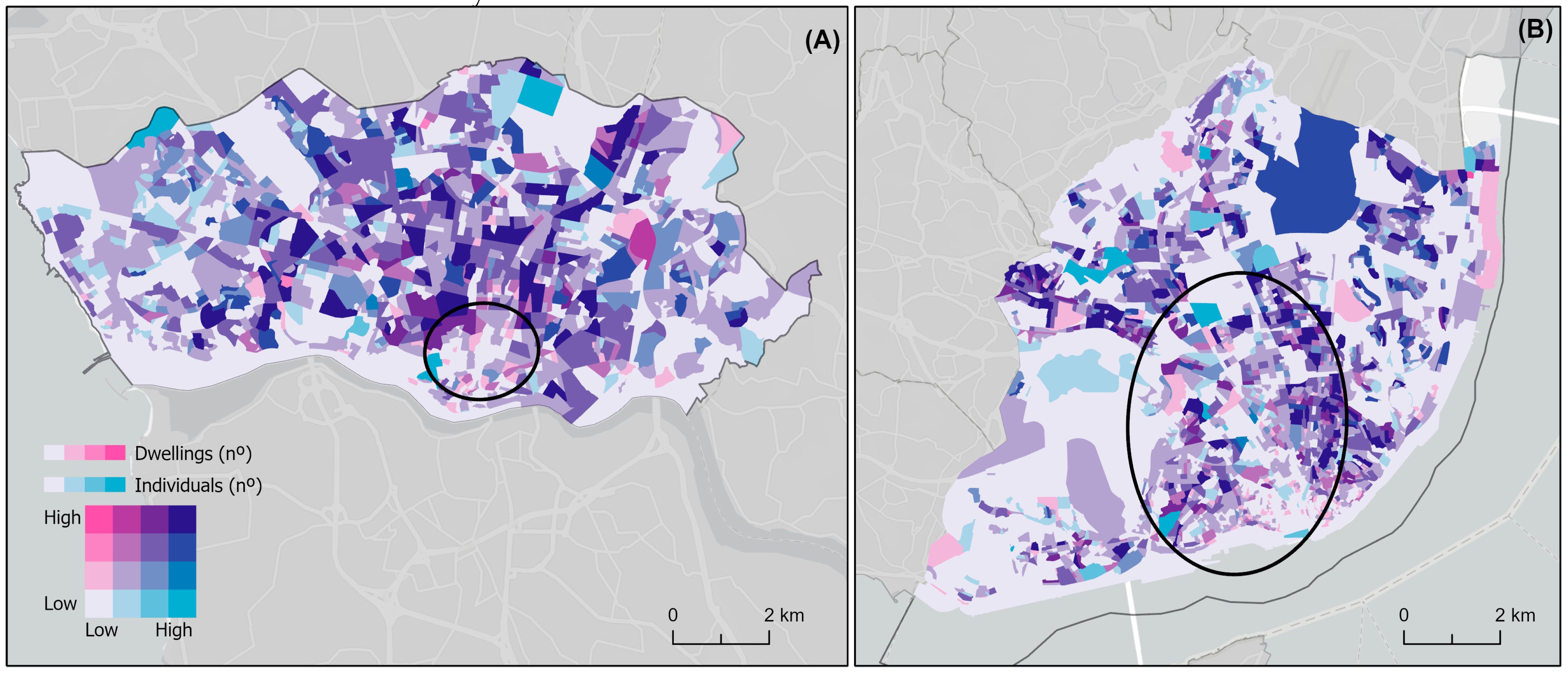
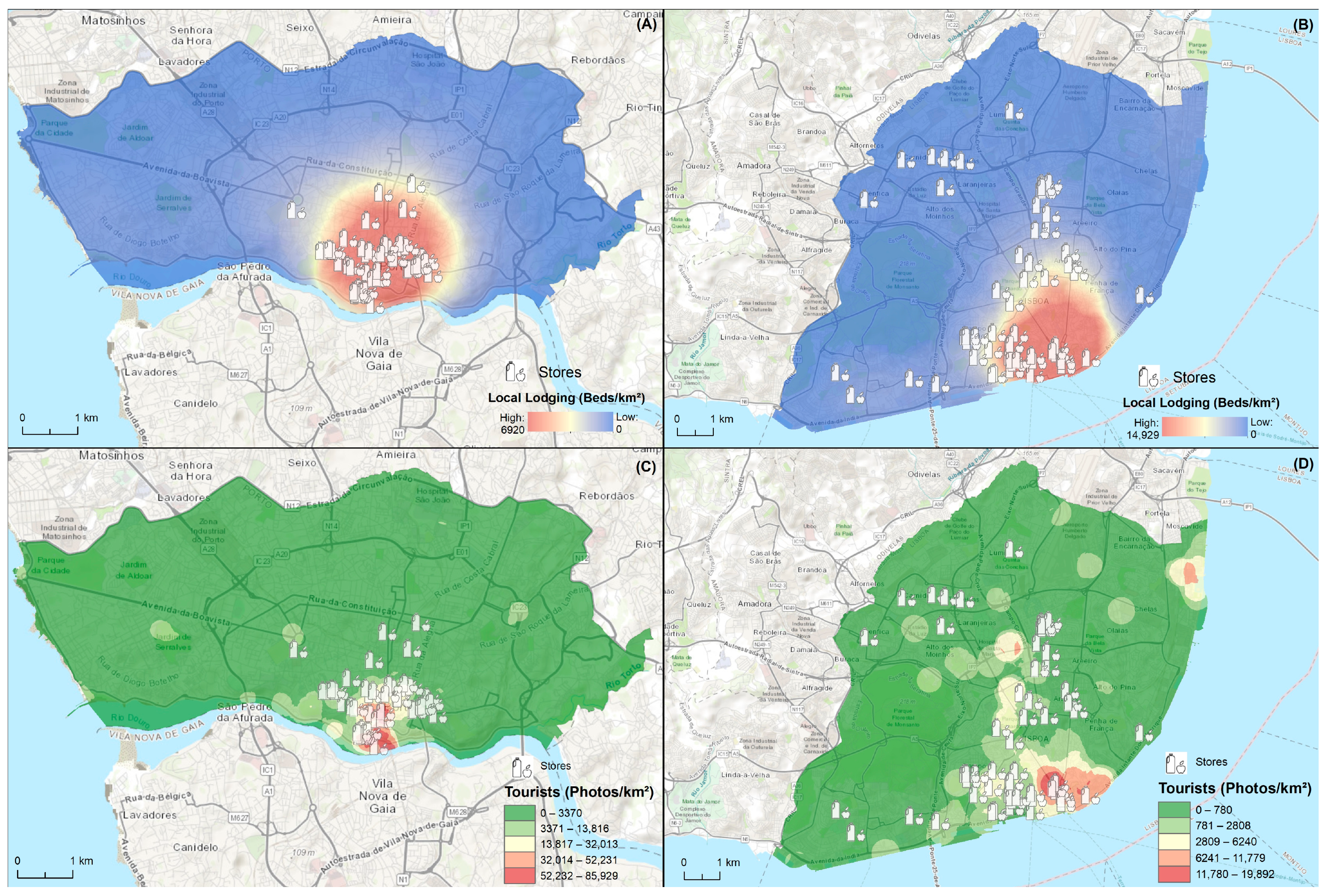
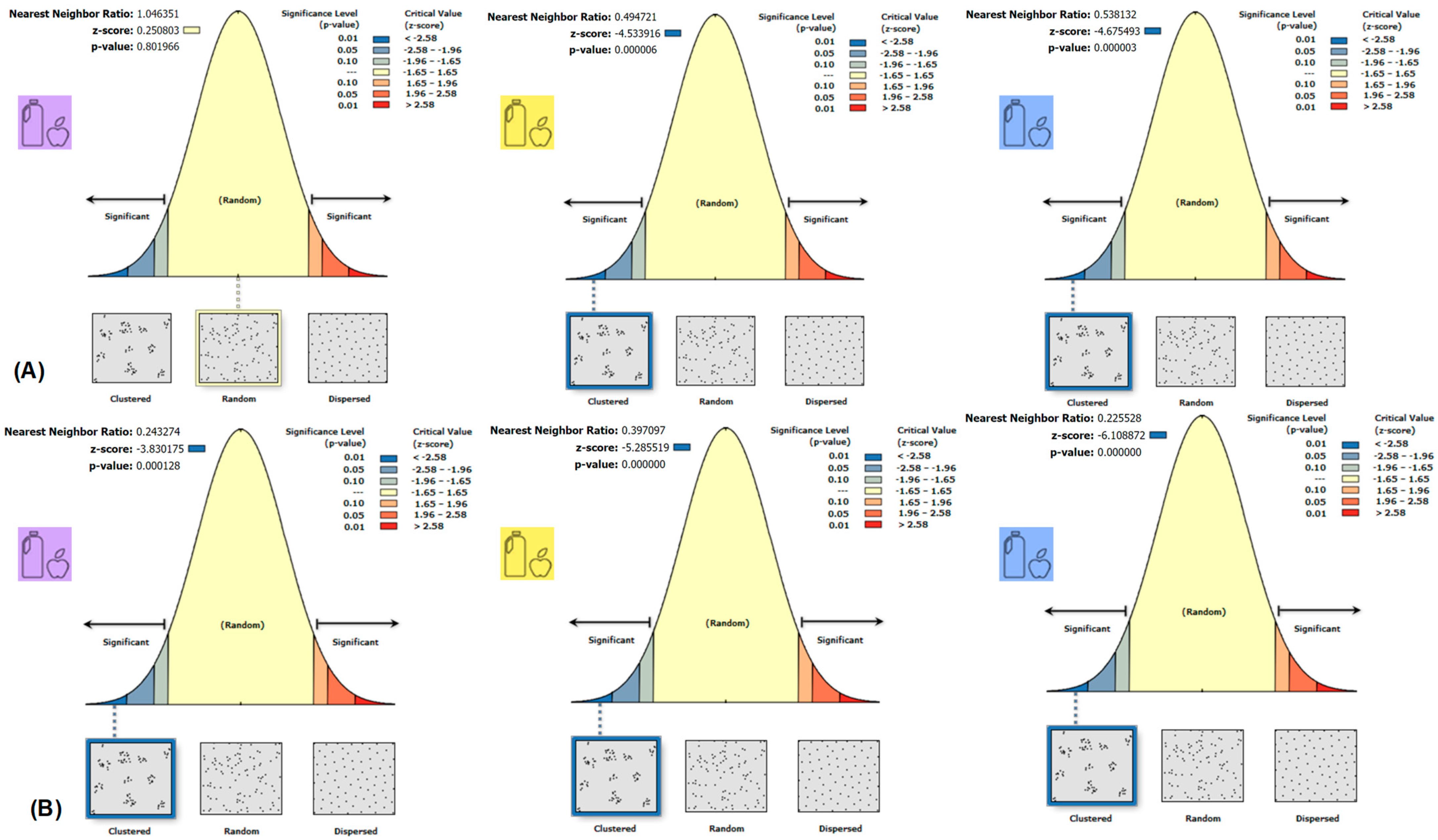
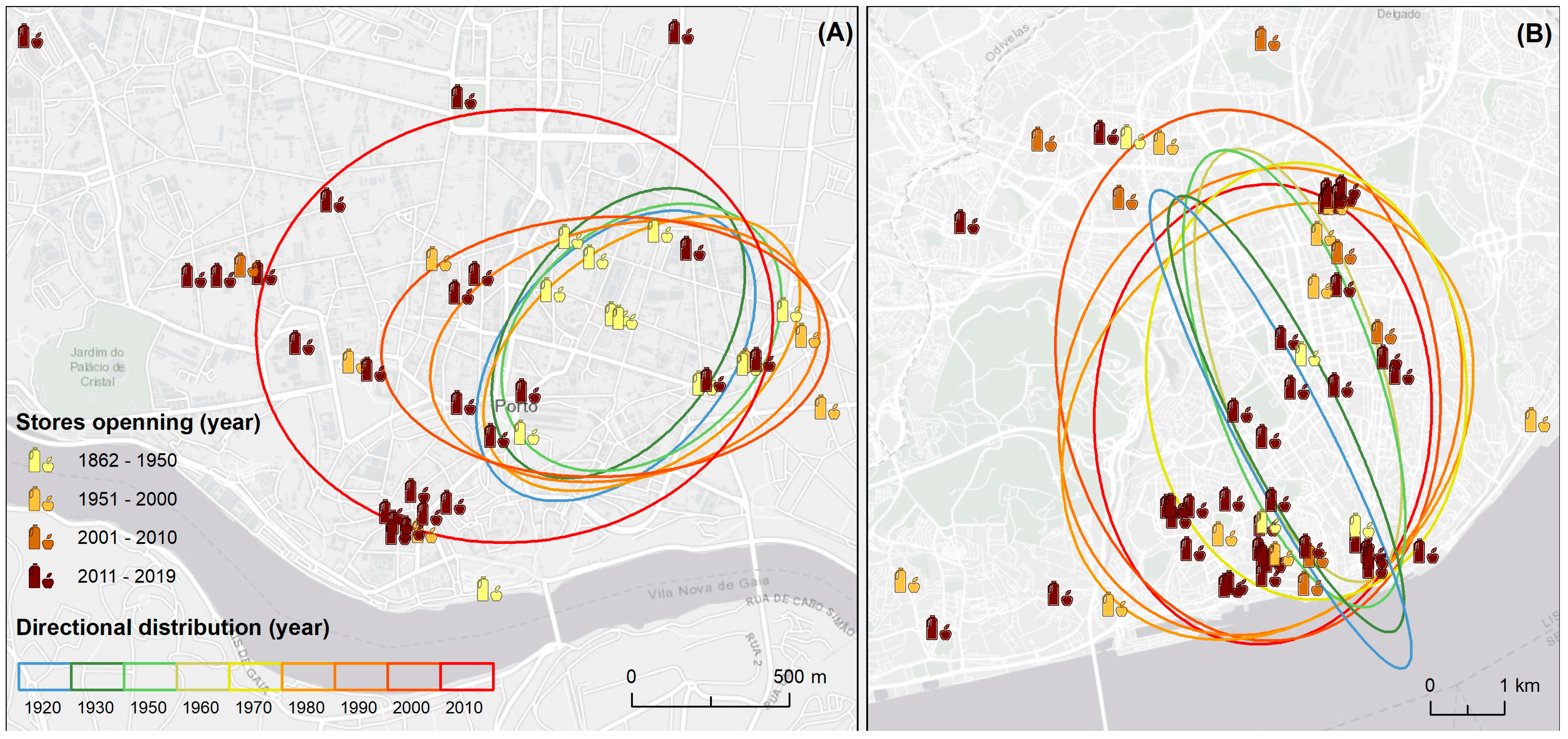
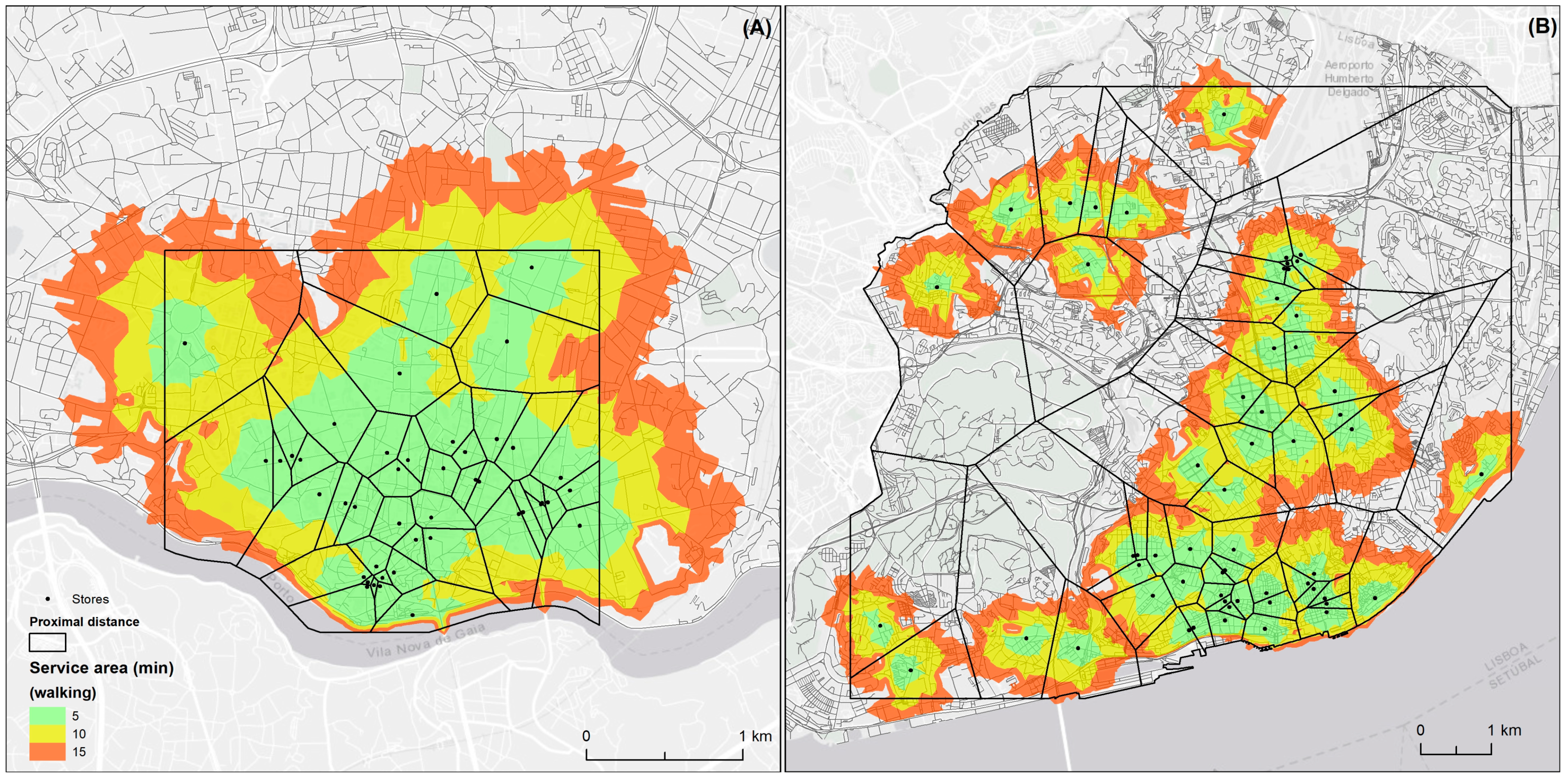
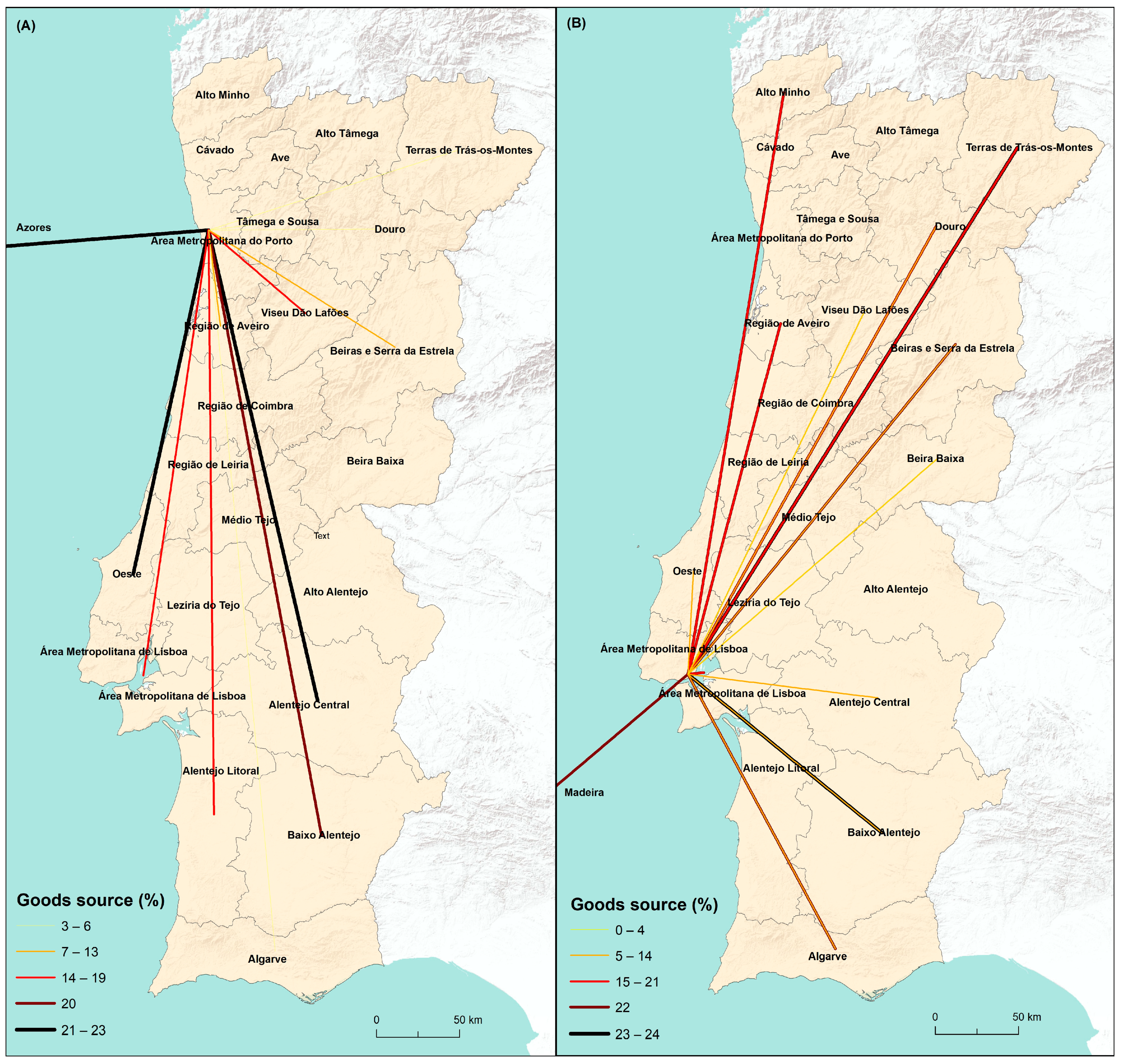
| Data | Geometry | Description | Date | Source |
|---|---|---|---|---|
| Stores | Point | Specialized/gourmet stores in Oporto and Lisbon | 2020 | Field work |
| Tourist photos | Point | Flickr photos uploaded by tourists | 2021 | Flickr social network |
| Local lodging | Point | Includes number of beds and carrying capacity | 2021 | National Tourism Authority |
| Road network | Lines | Includes metric and time distance attributes | 2021 | Here/ESRI |
| Geodemographic data | Polygon (subsection) | Urban quarters (includes dwellings and resident population data) | 2021 | Statistics Portugal |
| Oporto | Cluster 1 The Wine Focused | Cluster 2 The Rural Provenance Focused | Cluster 3 The Generalist |
|---|---|---|---|
| Observed average distance (m) | 295.8846 | 278.8454 | 176.0159 |
| Expected average distance (m) | 1216.2614 | 702.2088 | 780.4615 |
| Average nearest neighbor | 0.243274 | 0.397097 | 0.225528 |
| Z-score | −3.830175 | −5.285519 | −6.108872 |
| p-Value | 0.000128 | 0.000000 | 0.000000 |
| Lisbon | Cluster 1 The Wine Focused | Cluster 2 The Rural Provenance Focused | Cluster 3 The Generalist |
|---|---|---|---|
| Observed average distance (m) | 1704.7745 | 486.0530 | 468.6458 |
| Expected average distance (m) | 1623.2571 | 982.4790 | 870.8746 |
| Average nearest neighbor | 1.046351 | 0.494721 | 0.538132 |
| Z-score | 0.250803 | −4.533916 | −4.675493 |
| p-Value | 0.801966 | 0.000006 | 0.000003 |
Disclaimer/Publisher’s Note: The statements, opinions and data contained in all publications are solely those of the individual author(s) and contributor(s) and not of MDPI and/or the editor(s). MDPI and/or the editor(s) disclaim responsibility for any injury to people or property resulting from any ideas, methods, instructions or products referred to in the content. |
© 2023 by the authors. Licensee MDPI, Basel, Switzerland. This article is an open access article distributed under the terms and conditions of the Creative Commons Attribution (CC BY) license (https://creativecommons.org/licenses/by/4.0/).
Share and Cite
Ribeiro, C.; Viana, C.M.; Girão, I.; Figueiredo, E.; Rocha, J. The Spatiotemporal Links between Urban and Rural Regions through the Sale and Consumption of Agri-Food Products. Sustainability 2023, 15, 12038. https://doi.org/10.3390/su151512038
Ribeiro C, Viana CM, Girão I, Figueiredo E, Rocha J. The Spatiotemporal Links between Urban and Rural Regions through the Sale and Consumption of Agri-Food Products. Sustainability. 2023; 15(15):12038. https://doi.org/10.3390/su151512038
Chicago/Turabian StyleRibeiro, Carlos, Cláudia M. Viana, Inês Girão, Elisabete Figueiredo, and Jorge Rocha. 2023. "The Spatiotemporal Links between Urban and Rural Regions through the Sale and Consumption of Agri-Food Products" Sustainability 15, no. 15: 12038. https://doi.org/10.3390/su151512038
APA StyleRibeiro, C., Viana, C. M., Girão, I., Figueiredo, E., & Rocha, J. (2023). The Spatiotemporal Links between Urban and Rural Regions through the Sale and Consumption of Agri-Food Products. Sustainability, 15(15), 12038. https://doi.org/10.3390/su151512038








